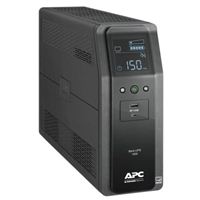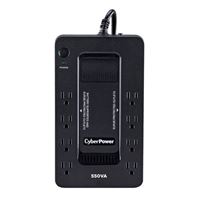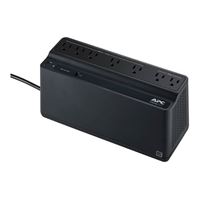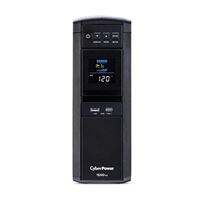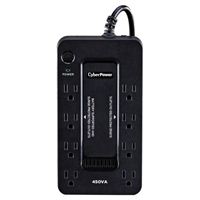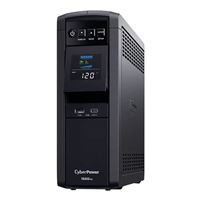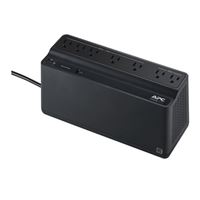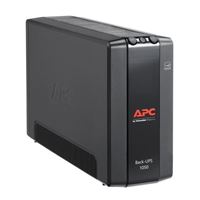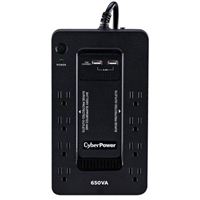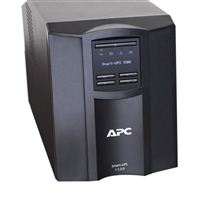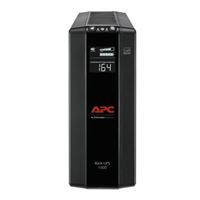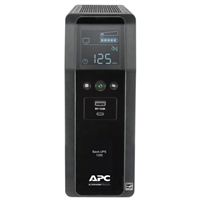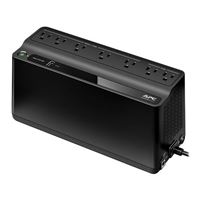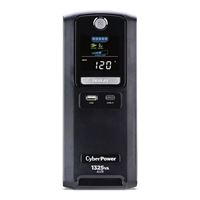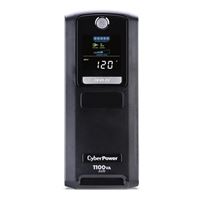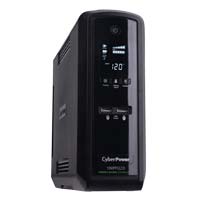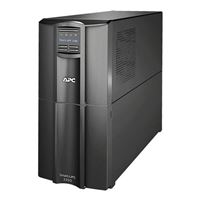Breadcrumbs
- Selected Refinements:
- Surge Suppressors, UPS Systemsx
- UPS Systemsx
Special Offers / Advertisements
Compare up to 4 items
New list of matching products
X
Sorry, you may compare a maximum of 4 items at a time.
Please clear one or more of your compare items before adding another-
SKU: 608661
- 1500 VA, 900 W, 115 V
- 10 Outlets & 2 USB Charging Ports
- Large LCD display
- Automatic Voltage Regulation
- 3-Year & $250K Warranty
- 1500 VA, 900 W, 115 V
- 10 Outlets & 2 USB Charging Ports
- Large LCD display
15 IN STOCK at Cambridge StoreOur price $179.99Original price $239.99Save $60.00 -
SKU: 357939
- 550 VA, 330 W, 120 V
- 8 Outlets
- EMI/RFI line noise filters
- Advanced Lightening Protection
- 3-Year & $100K Warranty
- 550 VA, 330 W, 120 V
- 8 Outlets
- EMI/RFI line noise filters
18 IN STOCK at Cambridge StoreOur price $54.99Original price $69.99Save $15.00 -
SKU: 255109
- 650 VA, 390 W, 120 V
- 7 Outlets & 1 USB Charging Ports
- Adjustable Voltage Sensitivity
- Automatic Self-Test
- 3-Year & $75K Warranty
- 650 VA, 390 W, 120 V
- 7 Outlets & 1 USB Charging Ports
- Adjustable Voltage Sensitivity
2 IN STOCK at Cambridge StoreOur price $99.99 -
SKU: 120709
- 1500 VA, 900 W, 120 V
- 12 Outlets
- Data Line Protection
- Automatic Voltage Regulation
- 3-Year & $500K Warranty
- 1500 VA, 900 W, 120 V
- 12 Outlets
- Data Line Protection
4 IN STOCK at Cambridge StoreOur price $229.99 -
SKU: 134874
- 450 VA, 270 W, 120 V
- 6 Outlets
- 7A Circuit Breaker
- Surge Protection All Outlet
- 3-Year & $75K Warranty
- 450 VA, 270 W, 120 V
- 6 Outlets
- 7A Circuit Breaker
5 IN STOCK at Cambridge StoreOur price $69.99 -
SKU: 417543
- 1500 VA, 900 W, 120 V
- 10 Outlets
- Automatic Voltage Regulation
- GreenPower UPS Technology
- 3-Year & $500K Warranty
- 1500 VA, 900 W, 120 V
- 10 Outlets
- Automatic Voltage Regulation
8 IN STOCK at Cambridge StoreOur price $199.99 -
SKU: 768309
- 450 VA, 270 W, 120 V
- 8 Outlets
- Standby Topology
- Full-time Surge Protection and Battery Backup
- 3-Year & $100K Warranty
- 450 VA, 270 W, 120 V
- 8 Outlets
- Standby Topology
2 IN STOCK at Cambridge StoreOur price $59.99 -
SKU: 180554
- 1500 VA, 1000 W, 120 V
- 10 Outlets & 2 USB Charging Ports
- Coax and Dataline protection
- Automatic Voltage Regulation
- 3-Year & $500K Warranty
- 1500 VA, 1000 W, 120 V
- 10 Outlets & 2 USB Charging Ports
- Coax and Dataline protection
5 IN STOCK at Cambridge StoreOur price $219.99Original price $259.99Save $40.00 -
SKU: 277368
- 900 VA, 540 W, 120 V
- 9 Outlets & 1 USB Charging Ports
- Mute button
- 3-Year & $75K Warranty
- 900 VA, 540 W, 120 V
- 9 Outlets & 1 USB Charging Ports
- Mute button
8 IN STOCK at Cambridge StoreOur price $139.99 -
SKU: 596148
- 1050 VA, 600 W, 120 V
- 8 Outlets
- Coax and Dataline Protection
- Automatic Voltage Regulation
- 3-Year & $250K Warranty
- 1050 VA, 600 W, 120 V
- 8 Outlets
- Coax and Dataline Protection
3 IN STOCK at Cambridge StoreOur price $179.99 -
SKU: 727677
- 900 VA, 480 W, 120 V
- 9 Outlets & 1 USB Charging Ports
- 2 Minute at Full Load
- Automatic Voltage Regulation
- 3-Year & $75K Warranty
- 900 VA, 480 W, 120 V
- 9 Outlets & 1 USB Charging Ports
- 2 Minute at Full Load
14 IN STOCK at Cambridge StoreOur price $99.99Original price $139.99Save $40.00 -
SKU: 768317
- 650 VA, 390 W, 120 V
- 8 Outlets & 2 USB Charging Ports
- Standby Topology
- Full-time Surge Protection and Battery Backup
- 3-Year & $125K Warranty
- 650 VA, 390 W, 120 V
- 8 Outlets & 2 USB Charging Ports
- Standby Topology
2 IN STOCK at Cambridge StoreOur price $79.99 -
SKU: 769844
- 1500 VA, 900 W, 120 V
- 8 Outlets
- SmartConnect
- Multi-Function LCD
- 3-Year Warranty
- 1500 VA, 900 W, 120 V
- 8 Outlets
- SmartConnect
2 IN STOCK at Cambridge StoreOur price $749.99 -
SKU: 768325
- 950 VA, 510 W, 120 V
- 12 Outlets & 2 USB Charging Ports
- Standby Topology
- Full-time Surge Protection and Battery Backup
- 3-Year & $150K Warranty
- 950 VA, 510 W, 120 V
- 12 Outlets & 2 USB Charging Ports
- Standby Topology
3 IN STOCK at Cambridge StoreOur price $109.99 -
SKU: 277376
- 1500 VA, 900 W, 120 V
- 10 Outlets & 2 USB Charging Ports
- LCD Display
- Automatic Voltage Regulation
- 3-Year & $50K Warranty
- 1500 VA, 900 W, 120 V
- 10 Outlets & 2 USB Charging Ports
- LCD Display
1 IN STOCK at Cambridge StoreOur price $359.99 -
SKU: 182881
- 1500 VA, 900 W, 120 V
- 10 Outlets
- Multi-Function LCD
- Automatic Voltage Regulation
- 3-Year & $250K Warranty
- 1500 VA, 900 W, 120 V
- 10 Outlets
- Multi-Function LCD
2 IN STOCK at Cambridge StoreOur price $199.99 -
SKU: 608646
- 1350 VA, 810 W, 120 V
- 10 Outlets
- Coaxial and Data Line Protection
- Automatic Voltage Regulation
- 3-Year & $250K Warranty
- 1350 VA, 810 W, 120 V
- 10 Outlets
- Coaxial and Data Line Protection
3 IN STOCK at Cambridge StoreOur price $229.99 -
SKU: 375451
- 600 VA, 360 W, 120 V
- 10 Outlets & 1 USB Charging Ports
- Adjustable voltage sensitivity
- Hot-swappable batteries
- 3-Year & $75K Warranty
- 600 VA, 360 W, 120 V
- 10 Outlets & 1 USB Charging Ports
- Adjustable voltage sensitivity
2 IN STOCK at Cambridge StoreOur price $99.99 -
SKU: 417535
- 1325VA, 810 W, 120 V
- 10 Outlets & 1 USB Charging Ports
- GreenPower UPS Bypass Technology
- PowerPanel Personal Edition
- 3-Year & $425K Warranty
- 1325VA, 810 W, 120 V
- 10 Outlets & 1 USB Charging Ports
- GreenPower UPS Bypass Technology
2 IN STOCK at Cambridge StoreOur price $179.99 -
SKU: 423590
- 1100 VA, 660 W, 120 V
- 10 Outlets
- Multi-function LCD status and control console
- Automatic Voltage Regulation
- 3-Year & $350K Warranty
- 1100 VA, 660 W, 120 V
- 10 Outlets
- Multi-function LCD status and control console
1 IN STOCK at Cambridge StoreOur price $169.99 -
SKU: 557025
- 650 VA, 390 W, 120 V
- 8 Outlets
- Network Protection
- Resettable Circuit Breaker
- 3-Year & $75K Warranty
- 650 VA, 390 W, 120 V
- 8 Outlets
- Network Protection
3 IN STOCK at Cambridge StoreOur price $139.99 -
SKU: 135301
- 1350 VA, 810 W, 120 V
- 10 Outlets
- GreenPower UPS Bypass Technology
- Automatic Voltage Regulation
- 3-Year & $425K Warranty
- 1350 VA, 810 W, 120 V
- 10 Outlets
- GreenPower UPS Bypass Technology
2 IN STOCK at Cambridge StoreOur price $279.99 -
SKU: 672444
- 3000 VA, 3000
- 9 Outlets
- GreenPower UPS Technology
- Automatic Voltage Regulation
- 3-Year & $400K Warranty
- 3000 VA, 3000
- 9 Outlets
- GreenPower UPS Technology
1 IN STOCK at Cambridge StoreOur price $1,709.99 -
SKU: 769810
- 2200 VA, 1320 W, 120 V
- 10 Outlets
- SmartConnect
- LCD display screen
- 3-Year & $150K Warranty
- 2200 VA, 1320 W, 120 V
- 10 Outlets
- SmartConnect
4 IN STOCK at Cambridge StoreOur price $1,299.99
Special Offers / Advertisements
{
'name': 'Back-UPS Pro UPS (BN1500M2)',
'id': '497071',
'price': '179.99',
'brand': 'APC',
'category': 'UPS Systems|566',
'list': 'Search Results',
'position': 1
},{
'name': 'Standby Series UPS (SX550G)',
'id': '319826',
'price': '54.99',
'brand': 'CyberPower Systems',
'category': 'UPS Systems|566',
'list': 'Search Results',
'position': 2
},{
'name': 'Back-UPS UPS (BVN650M1 )',
'id': '635490',
'price': '99.99',
'brand': 'APC',
'category': 'UPS Systems|566',
'list': 'Search Results',
'position': 3
},{
'name': 'Battery Backup UPS (GX1500U)',
'id': '623674',
'price': '229.99',
'brand': 'CyberPower Systems',
'category': 'UPS Systems|566',
'list': 'Search Results',
'position': 4
},{
'name': 'Battery Back-up UPS (BN450M)',
'id': '469027',
'price': '69.99',
'brand': 'APC',
'category': 'UPS Systems|566',
'list': 'Search Results',
'position': 5
},{
'name': 'Battery Back-up UPS (LX1500GUS )',
'id': '650743',
'price': '199.99',
'brand': 'CyberPower Systems',
'category': 'UPS Systems|566',
'list': 'Search Results',
'position': 6
},{
'name': 'Slim Battery Backup UPS (SE450G1)',
'id': '507391',
'price': '59.99',
'brand': 'CyberPower Systems',
'category': 'UPS Systems|566',
'list': 'Search Results',
'position': 7
},{
'name': 'PFC Sinewave Series UPS (CP1500PFCLCD)',
'id': '353897',
'price': '219.99',
'brand': 'CyberPower Systems',
'category': 'UPS Systems|566',
'list': 'Search Results',
'position': 8
},{
'name': 'Battery Backup And Surge Protector UPS (BVN900M1)',
'id': '637677',
'price': '139.99',
'brand': 'APC',
'category': 'UPS Systems|566',
'list': 'Search Results',
'position': 9
},{
'name': 'Back-UPS Pro UPS (BN1050M)',
'id': '668954',
'price': '179.99',
'brand': 'APC',
'category': 'UPS Systems|566',
'list': 'Search Results',
'position': 10
},{
'name': 'Back UPS (BVN900M1-CA)',
'id': '682817',
'price': '99.99',
'brand': 'APC',
'category': 'UPS Systems|566',
'list': 'Search Results',
'position': 11
},{
'name': 'Standby UPS (SX650U)',
'id': '507392',
'price': '79.99',
'brand': 'CyberPower Systems',
'category': 'UPS Systems|566',
'list': 'Search Results',
'position': 12
},{
'name': 'Smart UPS (SMT1500C)',
'id': '506633',
'price': '749.99',
'brand': 'APC',
'category': 'UPS Systems|566',
'list': 'Search Results',
'position': 13
},{
'name': 'Standby UPS (SX950U)',
'id': '507406',
'price': '109.99',
'brand': 'CyberPower Systems',
'category': 'UPS Systems|566',
'list': 'Search Results',
'position': 14
},{
'name': 'Back UPS PRO BR UPS (BR1500MS2)',
'id': '637675',
'price': '359.99',
'brand': 'APC',
'category': 'UPS Systems|566',
'list': 'Search Results',
'position': 15
},{
'name': 'Back UPS Pro BX 1500M UPS (BX1500M)',
'id': '629344',
'price': '199.99',
'brand': 'APC',
'category': 'UPS Systems|566',
'list': 'Search Results',
'position': 16
},{
'name': 'Back-Up UPS (BN1350M2)',
'id': '497068',
'price': '229.99',
'brand': 'APC',
'category': 'UPS Systems|566',
'list': 'Search Results',
'position': 17
},{
'name': 'Battery Backup And Surge Protector UPS (BE600M1)',
'id': '647002',
'price': '99.99',
'brand': 'APC',
'category': 'UPS Systems|566',
'list': 'Search Results',
'position': 18
},{
'name': 'Battery Backup And Surge Protector UPS (LX1325GU3)',
'id': '650634',
'price': '179.99',
'brand': 'CyberPower Systems',
'category': 'UPS Systems|566',
'list': 'Search Results',
'position': 19
},{
'name': 'Battery Backup Mini Tower UPS (LX1100G3)',
'id': '651373',
'price': '169.99',
'brand': 'CyberPower Systems',
'category': 'UPS Systems|566',
'list': 'Search Results',
'position': 20
},{
'name': 'Green Battery Backup UPS (BE650G1)',
'id': '366606',
'price': '139.99',
'brand': 'APC',
'category': 'UPS Systems|566',
'list': 'Search Results',
'position': 21
},{
'name': 'PFC Series UPS (CP1350PFCLCD)',
'id': '352110',
'price': '279.99',
'brand': 'CyberPower Systems',
'category': 'UPS Systems|566',
'list': 'Search Results',
'position': 22
},{
'name': 'Smart App UPS (PR3000RT2UCN)',
'id': '677527',
'price': '1,709.99',
'brand': 'CyberPower Systems',
'category': 'UPS Systems|566',
'list': 'Search Results',
'position': 23
},{
'name': 'Smart UPS (SMT2200C)',
'id': '506635',
'price': '1,299.99',
'brand': 'APC',
'category': 'UPS Systems|566',
'list': 'Search Results',
'position': 24
}
{'id': 'Tower',
'name': 'Micro Center eNews Banner',
'creative': 'https://60a99bedadae98078522-a9b6cded92292ef3bace063619038eb1.ssl.cf2.rackcdn.com/webp_MCNewsST.webp',
'position': '1' }


